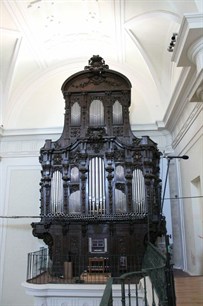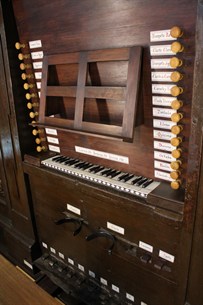The “Echevarría” organ in the cathedral of Santa María Magdalena (Getafe, Madrid)
 The church of Santa María Magdalena (Saint Mary Magdalene), nowadays the Cathedral of Getafe, has always had high quality organs, as it is a very busy temple because of the location of GetafeA city located in the southern part of the Comunidad de Madrid, Getafe is part of the metropolitan area of the capital. Although the evidence of human presence in the area dates back to prehistoric times, the origin of today’s Getafe dates back to the fourteenth century. In the Early Modern period the church of Nuestra Señora de la Magdalena (Our Lady of Mary Magdalene), the current cathedral, was erected., a mercantile centre exactly at the crossroads between Toledo and Madrid. In 1639, the master Mateo de Ávila Salazar made a organ, but the instrument was replaced by another Baroque organ in the eighteenth century, which you can see and listen to today during ceremonies (photo 1).
The church of Santa María Magdalena (Saint Mary Magdalene), nowadays the Cathedral of Getafe, has always had high quality organs, as it is a very busy temple because of the location of GetafeA city located in the southern part of the Comunidad de Madrid, Getafe is part of the metropolitan area of the capital. Although the evidence of human presence in the area dates back to prehistoric times, the origin of today’s Getafe dates back to the fourteenth century. In the Early Modern period the church of Nuestra Señora de la Magdalena (Our Lady of Mary Magdalene), the current cathedral, was erected., a mercantile centre exactly at the crossroads between Toledo and Madrid. In 1639, the master Mateo de Ávila Salazar made a organ, but the instrument was replaced by another Baroque organ in the eighteenth century, which you can see and listen to today during ceremonies (photo 1).
The new organ was built between 1726 and 1728, leaving a case of natural pine wood, without gold covering or polychrome. The identity of the person who assembled the organ is unknown, but recent studies suggest that, in all probability it was a builder tied to a family with a long tradition in this area: the EchevarríaWas one of the most important families of organ builders of Spain in the Baroque age, becoming builders for the king and his royal chapel. Among the family above all, Pedro Echevarría (1689-1724) stood out, for the large number of instruments he built, and his son Pedro Echevarría Liborna (1724-1771) for the prestige achieved as a builder for the king..
 Subsequent events, especially the Spanish Civil War (1936-1939), ended with the deterioration of the tubes and technical components of the instrument, which largely disappeared in the looting of the war with the exception of the Baroque case which remained intact and was then covered with a protective layer of varnish. The consoleThe organist’s place, where the keyboard is and the keyboard, the tiradores of the registers and all the tubería (the set of pipes) are based on a Baroque model. In fact, already in the twentieth century, upon removing the instrument to restore it, they found small pieces of metal that have allowed us to go back to the type of material used for the pipes that have disappeared and so to reconstruct the whole tubería with the alloy of tin and lead of the original organ (photo 2).
Subsequent events, especially the Spanish Civil War (1936-1939), ended with the deterioration of the tubes and technical components of the instrument, which largely disappeared in the looting of the war with the exception of the Baroque case which remained intact and was then covered with a protective layer of varnish. The consoleThe organist’s place, where the keyboard is and the keyboard, the tiradores of the registers and all the tubería (the set of pipes) are based on a Baroque model. In fact, already in the twentieth century, upon removing the instrument to restore it, they found small pieces of metal that have allowed us to go back to the type of material used for the pipes that have disappeared and so to reconstruct the whole tubería with the alloy of tin and lead of the original organ (photo 2).
 The case presents the typical ornaments of the first three decades of the eighteenth century and consists of three bodies. The first, where the console is situated, is decorated with side shelves (photo 3); above it, the second body, the main one, has three façades decorated with rods or columns, with five windows in the frontal façade and one for each of the lateral façades. The upper part is dominated by a curved pediment with three windows for the tuberías canónigasTubes that do not produce sound and which are placed on the façade of an organ as an ornament and to maintain symmetry..
The case presents the typical ornaments of the first three decades of the eighteenth century and consists of three bodies. The first, where the console is situated, is decorated with side shelves (photo 3); above it, the second body, the main one, has three façades decorated with rods or columns, with five windows in the frontal façade and one for each of the lateral façades. The upper part is dominated by a curved pediment with three windows for the tuberías canónigasTubes that do not produce sound and which are placed on the façade of an organ as an ornament and to maintain symmetry..
Technical data:
- Manual keyboard of 45 notes, C-c'”
- Short eighth
- 12 peanas de Pedal
- 26 medios registros
- Mechanical Transmission
- Secretos de corredera
